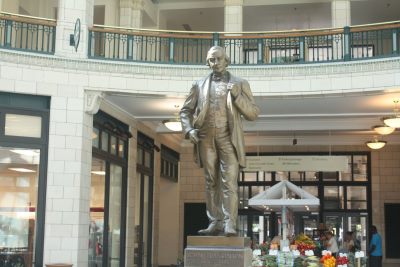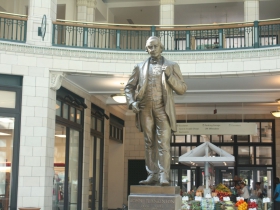The History of Plankinton Avenue
Once West Water St., it’s pretty short but long on history.

A view down Plankinton Ave. Photo by Brian Jacobson from the Vantage Point series.
One of the most common names for a street that runs along a body of water is, not surprisingly, Water Street. Each of the three settlements that ultimately formed the city of Milwaukee had a street along the Milwaukee River by that name. To reduce the confusion, they were given directional distinctions. For nearly a century, Kilbourntown’s entry, west of the river, was known as West Water Street, while Juneautown’s was East Water Street and the one in Walker’s Point was called South Water Street.
During the late 1920’s, the city instituted a renaming program to eliminate duplicate street names. Consequently, East Water Street became North Water Street while South Water Street, a continuation of North Water Street, but south of the north/south dividing line, retained its name.
The six-block long West Water Street though, had to have its name changed. The decision of what to rename it was easy. Two of the six blocks contained Plankinton buildings. The premier eight-story Plankinton Hotel was between Clybourn and Michigan Streets and the seven-story Plankinton Arcade was between Michigan Street and Wisconsin Avenue. The Arcade, today part of the Grand Avenue Mall, had replaced an earlier Plankinton House hotel, the leading facility of its kind in the city during its heyday. So in 1929, West Water Street was renamed North Plankinton Avenue (“Avenue” was considered classier than plain old “Street”).
The buildings and the street were named for John Plankinton, who was born in Delaware in 1820. After arriving in Milwaukee at age 24, he opened a butcher shop that would be the beginning of his financial empire, which included meat packing plants in Milwaukee, Kansas City, New York and other cities, as well as real estate, railroad interests and other endeavors. At various times he was in partnerships with meatpackers Frederick Layton, Philip Armour, and Patrick Cudahy.
His hotel was his hobby and he spared no expense in assuring it was first class. He brought in dynamos to furnish it with electric lighting, the first such illumination in the city. He was a civic-minded man and when he built a mansion on Grand Avenue, he required that it be built only of local materials and solely by local craftsmen. Plankinton died in 1891 at age 71 and is buried in Forest Home Cemetery.
The city of Plankinton, South Dakota was named for him, recognizing him as a director of the Milwaukee Road railroad, and Patrick Cudahy laid out East Plankinton Avenue in Cudahy, the meatpacking town he was developing, shortly after the death of his former partner.
Inside the Plankinton Arcade there is a statue and a portrait of John Plankinton. A marker there tells us that General Douglas MacArthur at one time lived in the old Plankinton House hotel that was formerly on the site. His grandfather, Arthur MacArthur, Sr., was a Milwaukee judge, and his father, Arthur MacArthur Jr., was career military man. Arthur Jr. and Douglas were the first father and son to each win a Medal of Honor (President Teddy Roosevelt and his son, Ted Jr., were the others). Arthur won his as an 18-year-old member of the Milwaukee Regiment during the Civil War because he “seized the colors of his regiment at a critical moment and planted them on the captured works on the crest of Missionary Ridge,” according to his citation. Douglas received his as a 62-year-old for his leadership in the Pacific Theater during World War II.
The south end of North Plankinton Avenue starts at the Menomonee River where the Pritzlaff Building has been converted to an events facility. The block to the north is all concrete and weeds, thanks to the freeway. There is an historical marker in the block north of Wisconsin Avenue showing where the temporary home for Civil War soldiers was located from 1864 to 1867, before the National Soldiers’ Home was built on West National Avenue (now the VA Medical Center). The site of the temporary home is now occupied by a huge, concrete cylinder that is part of a parking structure.
North of West Wells Street is a statue commemorating the 100-year anniversary of the founding of the National Association of Letter Carriers. The founding took place in 1889 in a building on North Plankinton Avenue across the street from the statue which was erected in 1989.
The north end of the street terminates at West Kilbourn Avenue, where the old Second Ward Bank now houses the Milwaukee County Historical Society‘s museum and archives. The cornice of the building, which was completed in 1913, has badly deteriorated and is wrapped to prevent debris from falling on passersby. It will take several million dollars to repair it but no funds are in sight.
North Plankinton Avenue used to run along the east side of the former bank but it was vacated to help create Père Marquette Park. According to a commemorative plaque in the park, Father Jacques Marquette set up camp along the river at that site in 1674. There is also a statue of the priest and two markers commemorating the 350th anniversary of his birth – one in English, one in French. The gazebo in the park is the focus of River Rhythm concerts and other activities.
Carl Baehr, a Milwaukee native, is the author of Milwaukee Streets: the Stories Behind their Names, and articles on local history topics. He has done extensive research on the sinking of the steamship Lady Elgin, the Newhall House Fire, and the Third Ward Fire for his upcoming book, “Dreams and Disasters: A History of the Irish in Milwaukee.” Baehr, a professional genealogist and historical researcher, gives talks on these subjects and on researching Catholic sacramental records. He earned an MLIS from the UW-Milwaukee School of Information Studies.
Sites Along Plankinton Avenue
City Streets
-
The Curious History of Cathedral Square
 Sep 7th, 2021 by Carl Baehr
Sep 7th, 2021 by Carl Baehr
-
Gordon Place is Rich with Milwaukee History
 May 25th, 2021 by Carl Baehr
May 25th, 2021 by Carl Baehr
-
11 Short Streets With Curious Names
 Nov 17th, 2020 by Carl Baehr
Nov 17th, 2020 by Carl Baehr





























Plankinton is one of my favorite streets/avenues in the city. The intersection of Plankinton and Wells has so much potential to be used for mix use. Redesign the street to enlarge the small square that the statue sits on, add some retail and sidewalk cafe/restaurant and you’d have gold.
@Casey I agree about Plankinton/Wells/2nd. I’ve often thought that either Plankinton or 2nd should be opened to pedestrian/bicycle traffic only (closed to vehicular traffic) next to the small square – in other words only one of the two streets would be open to vehicular traffic north of Wells. This would require rerouting the 19, 33, and 42U bus routes, but those routes make a number of turns in that area as is and could potentially benefit by straightening the route, or at least not be significantly harmed by perhaps moving them to 3rd Street.
The square at that location has additional historic significance. It is the place where the Milwaukee 13, in protest of the Vietnam War, ignited the Selective Service files that they had removed from government offices which were in the Brumder Building across the street.
After starting the fire with napalm, the group united in prayer while waiting to be arrested.
Milwaukee 14
Looking at the pictures, I never really put together how many monuments, memorials, etc there are in that small area!
In keeping with Mr. Baehr’s City Streets series, this is an excellent, consciousness-raising article. As a pedant, however, I must make a couple of corrections: The second Plankinton House Hotel was not located in the block between Michigan and Clybourn Strteets, where the former Gimbels’ parking structure and “Electric City” appliance store now sit, but on the northwest corner of Plankinton and MIchigan, immediately to the south of the Plankinton Arcade building, a site on which the Grand Avenue parking garage now stands. Its Sky Room restaurant, with its barrel-vaulted ceiling often served as an auxiliary ballroom, in which banquets and ceremonial events, a couple of which I attended in the late 1950’s and early 1960’s. The hotel in its later years deteriorated and lost its first-class standing and eventually closed. It was demolished for the aforementioned Grad Avenue mall parking structure.
The second error is the caption for photo #12, which is labeled as the Plankinton Arcade, when, in reality it is the old Gimbels(and later Marshall Field’s, department store. The store was a first in a chain established in the late 19th century by Adam Gimbel. Gimbel had started out as a traveling peddler in rural Indiana, saving enough of the proceeds of his sales to open a shop in Vincennes, Indiana. He was successful enough to hit the “big time” in the rapidly growing city of MIlwaukee, where he established his first department store at Plankinton and Grand–now Wisconsin–Avenues in the 1880’s. By the turn of the century, he was able to build a Daniel-Burnham-designed eight-story addition to the original store, which was eventually demolished and replaced with more eight-story additions. The Milwaukee was subsequently followed by large stores in New York CIty, where it became an arch-competitor to the adjacent R.H. Macy Company, and in Philadelphia and Pittsburgh, as well as by suburman stores in all four metropolitan areas. The chain fell victim to both the leveraged-buyout craze in the 1980’s and by changing retail buying patterns. The Milwaukee store was first sold to Marshall Field’s of Chicago and closed when its sales failed to measure up to those in the Mayfair store. The building was redeveloped as a multi-purpose facility, which now houses the offices of the American Society for Quality, a Marriott hotel, and Planet Fitness. I might speculate that the captioning error stemmed from some understandable confusion caused by the pedestrian bridge connection to the real Plankinton Arcade, a connection made as a part of the development of the Grand Avenue Mall.
PG1946,
Thank you for your comments and corrections. The photo captioned the “Plankinton Arcade” should be captioned “the former Gimbels store” and the location of the second Plankinton Hotel was north of Michigan Street not south of it. I appreciate you taking the time to set the record straight and for adding background information.